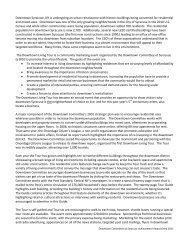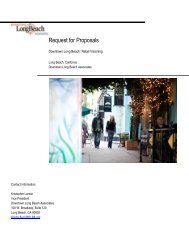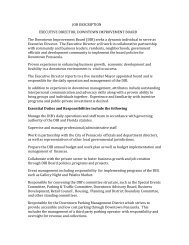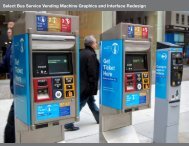The Value of Investing in Canadian Downtowns - International ...
The Value of Investing in Canadian Downtowns - International ...
The Value of Investing in Canadian Downtowns - International ...
You also want an ePaper? Increase the reach of your titles
YUMPU automatically turns print PDFs into web optimized ePapers that Google loves.
<strong>The</strong> Decl<strong>in</strong><strong>in</strong>g Downtown – 1950 - 1980s<br />
In the post war era, each <strong>of</strong> the downtowns featured <strong>in</strong> CUI’s case studies underwent a period <strong>of</strong> economic decl<strong>in</strong>e<br />
and reduced <strong>in</strong>terest; some faced a more serious state <strong>of</strong> decl<strong>in</strong>e than others. This decl<strong>in</strong>e was generally brought<br />
about by <strong>in</strong>creased congestion <strong>in</strong> the core, higher land values out <strong>of</strong> sync with economic returns and deteriorat<strong>in</strong>g<br />
surround<strong>in</strong>g neighbourhoods, accompanied by a perception that downtowns were fast becom<strong>in</strong>g less desirable to<br />
bus<strong>in</strong>esses and residents. <strong>The</strong> mix <strong>of</strong> uses was also be<strong>in</strong>g seen <strong>in</strong> a more negative light aga<strong>in</strong>st emerg<strong>in</strong>g zon<strong>in</strong>g<br />
regimes that sought to segregate land uses across cities. Moreover, decl<strong>in</strong><strong>in</strong>g support for downtowns was coupled<br />
with major technological advancements that were dramatically alter<strong>in</strong>g the production and movement <strong>of</strong> goods and<br />
the way people moved around the city. <strong>The</strong> advent <strong>of</strong> climate controlled build<strong>in</strong>gs ushered <strong>in</strong> a reduced <strong>in</strong>terest <strong>in</strong><br />
street related activity. <strong>The</strong>se factors comb<strong>in</strong>ed <strong>in</strong> a powerful way, to hollow out the downtown <strong>of</strong> bus<strong>in</strong>esses and<br />
residents and facilitated what is <strong>of</strong>ten known as a ‘flight to the suburbs.’ In response to this challenge, downtowns<br />
were <strong>of</strong>ten the focus <strong>of</strong> large scale revitalization efforts, such as major highway projects, hous<strong>in</strong>g developments and<br />
enclosed shopp<strong>in</strong>g malls. <strong>The</strong>se projects had vary<strong>in</strong>g levels <strong>of</strong> success, but each project had an endur<strong>in</strong>g impact on<br />
the form and structure <strong>of</strong> the “downtown” for decades to come.<br />
<strong>The</strong> Downtown Renaissance – 1980s - 90s - 2000s<br />
In the 1980s many municipalities started to re-evaluate what was happen<strong>in</strong>g <strong>in</strong> their downtowns. <strong>The</strong>re was a<br />
grow<strong>in</strong>g understand<strong>in</strong>g that a strong downtown was not just beneficial to those with vested <strong>in</strong>terests, but was a<br />
stimulator for economic growth and potentially a key revenue<br />
generator for local government.<br />
Revitalization efforts began once aga<strong>in</strong>, but a different approach was<br />
adopted than those <strong>of</strong> the earlier decades. <strong>The</strong>se revitalization<br />
approaches focused on enhanc<strong>in</strong>g the unique, physical and heritage<br />
features compris<strong>in</strong>g the downtown cores. Efforts were focused on<br />
areas where the downtown enjoyed a competitive advantage and<br />
was able to differentiate the downtown experience from the suburbs.<br />
<strong>The</strong>se efforts co<strong>in</strong>cided with renewed attempts to achieve a mix <strong>of</strong><br />
land uses (rather than the more segregated approach <strong>of</strong> the previous<br />
decades) and had a strong focus on br<strong>in</strong>g<strong>in</strong>g residential development<br />
back to the downtown.<br />
Dur<strong>in</strong>g this period, bus<strong>in</strong>ess improvement districts were also start<strong>in</strong>g<br />
to grow <strong>in</strong> strength and contribute to revitalization efforts. <strong>The</strong> first<br />
ever Bus<strong>in</strong>ess Improvement Area (BIA) was established <strong>in</strong> the 1970s<br />
<strong>in</strong> Toronto’s Bloor West Village 1 and this movement has s<strong>in</strong>ce spread<br />
throughout the world. Currently there are close to 400 BIAs<br />
throughout Canada and many <strong>of</strong> these groups have been work<strong>in</strong>g<br />
hard to improve quality <strong>of</strong> life <strong>in</strong> their downtowns.<br />
Overall, as illustrated <strong>in</strong> these case studies, downtowns are well on<br />
their way to com<strong>in</strong>g full circle. Each <strong>of</strong> the downtowns featured are<br />
surg<strong>in</strong>g forward, focused on rebuild<strong>in</strong>g their strength and momentum<br />
to emerge as the centre and heart <strong>of</strong> their respective communities.<br />
1<br />
TABIA. (2011). Resource Guide for BIAs and Small Bus<strong>in</strong>esses, 2011 – 2012. Retrieved from:http://www.torontobia.com/images/stories/tabia/ResourceGuide/resourceguide_2011_web.pdf.<br />
Accessed 2011 September 12.<br />
A transform<strong>in</strong>g street corner <strong>in</strong> downtown Victoria<br />
exemplifies these dist<strong>in</strong>ct stages <strong>of</strong> Canada’s downtown<br />
evolution. Historic build<strong>in</strong>g was replaced with a gas station<br />
<strong>in</strong> the 1970’s. A condom<strong>in</strong>ium build<strong>in</strong>g is start<strong>in</strong>g<br />
construction <strong>in</strong> 2007.<br />
Source: http://www.flickr.com/photos/westcoasthistory/501140525/<br />
10
















